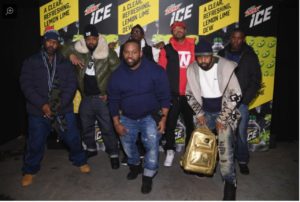The Original Story of Kimba/Simba controversy
Hollywood could never come up with something original they’re always stealing and one state stolen the greatness from someone else. The producers directors never give credit where credit is due especially if it’s a minority .
Louisiana School Made Headlines for Sending Black Kids to Elite Colleges. Here’s the Reality.
M. Landry, a school in small-town Louisiana, has garnered national attention for vaulting its underprivileged black students to elite colleges. But the school cut corners and doctored college applications.
BREAUX BRIDGE, La. — Bryson Sassau’s application would inspire any college admissions officer.
A founder of T.M. Landry College Preparatory School described him as a “bright, energetic, compassionate and genuinely well-rounded” student whose alcoholic father had beaten him and his mother and had denied them money for food and shelter. His transcript “speaks for itself,” the founder, Tracey Landry, wrote, but Mr. Sassau should also be lauded for founding a community service program, the Dry House, to help the children of abusive and alcoholic parents. He took four years of honors English, the application said, was a baseball M.V.P. and earned high honors in the “Mathematics Olympiad.”
The narrative earned Mr. Sassau acceptance to St. John’s University in New York. There was one problem: None of it was true.
“I was just a small piece in a whole fathom of lies,” Mr. Sassau said.
T.M. Landry has become a viral Cinderella story, a small school run by Michael Landry, a teacher and former salesman, and his wife, Ms. Landry, a nurse, whose predominantly black, working-class students have escaped the rural South for the nation’s most elite colleges. A video of a 16-year-old student opening his Harvard acceptance letter last year has been viewed more than eight million times. Other Landry students went on to Yale, Brown, Princeton, Stanford, Columbia, Dartmouth, Cornell and Wesleyan.
Landry success stories have been splashed in the past two years on the “Today” show, “Ellen” and the “CBS This Morning.” Education professionals extol T.M. Landry and its 100 or so kindergarten-through-12th-grade students as an example for other Louisiana schools. Wealthy supporters have pushed the Landrys, who have little educational training, to expand to other cities. Small donors, heartened by the web videos, send in a steady stream of cash.
Abuse, Fear and Intimidation: How Viral Videos Masked a Prep School’s Problems
T.M. Landry College Prep, a small private school in Louisiana, boasted about its record of sending black students from working-class families to top universities. But there’s more to the story.
In reality, the school falsified transcripts, made up student accomplishments and mined the worst stereotypes of black America to manufacture up-from-hardship tales that it sold to Ivy League schools hungry for diversity. The Landrys also fostered a culture of fear with physical and emotional abuse, students and teachers said. Students were forced to kneel on rice, rocks and hot pavement, and were choked, yelled at and berated.
The Landrys’ deception has tainted nearly everyone the school has touched, including students, parents and college admissions officers convinced of a myth.
The colleges “want to be able to get behind the black kids going off and succeeding, and going to all of these schools,” said Raymond Smith Jr., who graduated from T.M. Landry in 2017 and enrolled at N.Y.U. He said that Mr. Landry forced him to exaggerate his father’s absence from his life on his N.Y.U. application.
“It’s a good look,” these colleges “getting these bright, high-flying, came-from-nothing-turned-into-something students,” Mr. Smith said.
Editors’ Picks
This portrait of T.M. Landry emerged from interviews with 46 people: parents of former Landry students; current and former students; former teachers; and law enforcement agents. The New York Times also examined student records and court documents showing that Mr. Landry and another teacher at the school had pleaded guilty to crimes related to violence against students, and police records that included multiple witness statements saying that Mr. Landry hit children. The Breaux Bridge Police Department closed the case after deciding it was outside of its jurisdiction.
“That dream you see on television, all those videos,” said Mr. Sassau’s mother, Alison St. Julien, “it’s really a nightmare.”
In an interview with The Times, the Landrys denied falsifying transcripts and college applications, but Mr. Landry admitted that he hit students and could be rough. “Oh, I yell a lot,” he said. He goads black and white students to compete against one another because that is how the real world works, he said.
In 2013, Mr. Landry was sentenced to probation and attended an anger management program after pleading guilty to a count of battery. Despite the documentation, he insisted that he did not plead guilty or serve probation. Mr. Landry said that the victim was a student whose mother asked him to hit her child, and he said he had eased up on physical punishments.
“I don’t do that anymore,” he said.
Instead, he calls himself a “drill sergeant” or “coach,” and asks children to kneel before him to learn humility, for five minutes at most, Mr. Landry said.
That is not how the students have experienced it. Tyler Sassau, Mr. Sassau’s brother, said he can still feel the humiliation and smell the stench on his clothes from kneeling last year on a bathroom floor for nearly two hours.
“I wasn’t going to get up without asking him because if I did, I could’ve got something worse,” he said. “I could barely stand when I got up.”
In their defense, the Landrys touted the school’s ACT scores and high graduation and college enrollment statistics.
“We get pushed under the microscope, or under the dagger,” Mr. Landry said, because “it had been just black kids going. Society kept saying all these negative things about us because it was just easy to beat this broken-down school.”
The students who navigated the Landrys’ system and made it to the nation’s top colleges now face their own quandaries.
“I really believe that we all thought we were doing the right thing at the time, and didn’t have a choice,” Mr. Smith said. “It was a cultish mentality.”
T.M. Landry produced its first graduating class in 2013, and since then, 50 students have graduated, according to the school’s promotional materials. They have had mixed success in college.
Some alumni, especially those who spent only a short time at T.M. Landry, have been successful. Bryson Sassau did well in his classes at St. John’s, although he had to quit some advanced science and math courses. Mr. Smith also did well, but with debts mounting had to drop out after his freshman year. Another Landry graduate said he feels at home at Brown in his junior year, has maintained good grades and was recently accepted into a program that prepares students to pursue a doctoral degree.
The student in the most viral video, who spent only a short time at Landry, is in his first semester at Harvard. Other Landry students have been admitted to Harvard over the past three years, but the university declined to provide information on their status.
For more on this story visit The NYT
New Documentary to Shed Light on Why Wu-Tang Clan Ain’t Nuthing ta F’ Wit

(L-R) Masta Killa, Ghostface Killah, RZA, Method Man, GZA, (front) Raekwon and Cappadonna of Wu Tang Clan attends the Mtn Dew ICE launch event on January 18, 2018 in Brooklyn, New York. Photo: Dimitrios Kambouris (Getty Images for Mountain Dew)
Cinematographer Hans Charles wanted to visually frame the Wu-Tang Clan and all of their personas in a way that celebrated each of them as thriving black men in America. Likewise, director Sacha Jenkins understood that the real story in their four-hour documentary on Wu-Tang’s music and legacy is really about “black men who knew each other as boys coming together and using their creativity to overcome the madness they faced growing into young men,” Jenkins said.
In an exclusive interview with The Root, the pair shared that their collaboration will result in the most comprehensive, visual story to date of the Clan with a new, as yet untitled documentary that’s due out next year.
“Rappers who have been able to make it, who have been consistent, managed the height of their career and still manage a career after hit records and have cultural influence are genuinely smart people,” said Charles about Wu Tang, “We tend to overlook that about them and think it’s just luck.”
Wu-Tang—whose original members included RZA, GZA, Raekwon, Method Man, Ghostface Killah, Inspectah Deck, Masta Killa, U-God and the late, great Ol’ Dirty Bastard—may be the one of the few rap group from the early ’90s who still tours and brings an inter-generational excitement to everything they touch. The group spawned all kinds of ancillary Wu-related content—including books like The Wu-Tang Manual, the Wu-Wear fashion line, The Nine Rings of Wu-Tang comic book series, not to mention the countless solo albums from individual members and affiliate members like the Killa Beez. RZA and GZA even kicked it in a movie with Bill Murray.
For Charles and Jenkins, telling Wu-Tang’s story is partly telling their own hip-hop story. Charles grew up in Connecticut listening to New York radio. Since then, he has shot for Spike Lee and, most recently, for a critically acclaimed documentary on Ellis Haizlip and the groundbreaking PBS show, Soul! He was nominated for an Emmy for his cinematography for Ava DuVernay’s 13th and has his first feature film, I Angry Black Man, coming out next year.
For Jenkins the connections are even more personal. He published the first cover story on the group in 1992, before anyone knew them, for his startup newspaper, Beat Down. He has since produced documentaries on hip-hop—Fresh Dressed, about the mainstreaming of hip-hop fashion, and Showtime’s Word is Bond, about hip-hop’s Bronx-born history.
Charles’ and Jenkins’ collaboration on Wu-Tang is a comprehensive history culled from exhaustive interviews with every member of the group, family members and archival footage.
“We really went in,” said Charles. “Their story origin in and of itself is so fascinating and so layered.”
That origin story begins in Staten Island, the forgotten borough of New York, and a character itself in the film.
“There’s no way you can talk about Wu Tang without talking about the importance of Staten Island,” said Charles. “We walked the hallways where they grew up. You’ll be surprised when the brothers talk about how it shaped them and what it meant to them.”
Jenkins agrees, adding, “A lot of their mothers migrated from Brooklyn because they heard it was a better quality of life. Eventually they discovered that all the things they were trying to escape in Brooklyn followed them to Staten Island.
“They were unabashedly from the projects, and not changing who they were to fit in or to entertain people. They were talking about their lives and what they were up against and people found it relatable,” said Jenkins. Their unfiltered rawness, quirky hobbies and obsessions, and Five Percent-inspired philosophies resonated with people from all walks of life. “We listened to Wu-Tang to survive private school, in college they got us through,” said Charles. “They were helping the black nerds, too.”
At the Anthem in Washington, D.C., earlier this month, the now 10-member Clan (longtime collaborator Cappadonna became an official member in 2007) came together for their reunion tour to celebrate the 25th anniversary of Enter the Wu-Tang (36 Chambers), with Redman, another longtime collaborator, as the opening act. ODB was replaced by his son, the Young Dirty Bastard, who is the spitting image of his father, down to the comic and manic shimmy, shimmy ya ya-ing across the stage with all of the mannerisms of his father. Raekwon, now a wine connoisseur, has a little more weight around his mid-section, and GZA, a vegan now, has a little less hair, but they still brought the same energy to their stage show that always ends with fifty-eleven people onstage.
The crowd, many dressed in Wu-Wear, featured everybody from white people from the cornfields of Iowa to elderly couples, wanna-be-thugs and actual thugs. The eclectic crowd was just more proof that with RZA as the philosophical leader, the group continues to have a profound worldwide cultural impact.
“Wu Tang for many people around the world was their introduction to hip hop. Around the world they don’t see Wu Tang as a rap group, they see them as embodying the essence of what hip hop really is,” said Jenkins.











